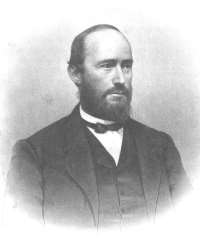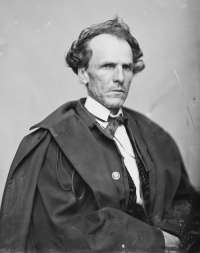Thomas Farmhouse Historical Marker
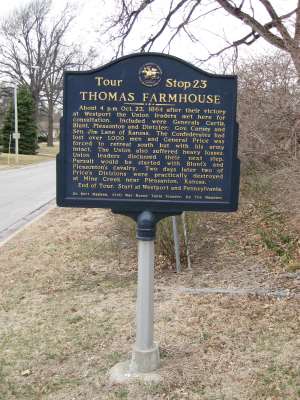
Thomas Farmshouse Historical Marker Inscription
"About 4:00 P.M. October 23, 1864, after their victory at Westport, the Union leaders met here for consultation. Included were Generals Curtis, Blunt, Pleasonton and Dietzler; Gov. Carney and Senator Jim Lane of Kansas. The Confederates had lost over 1,000 men and General Price was forced to retreat south but with his army intact. The Union also suffered heavy losses. Union leaders discussed their next step. Pursuit would be started with Blunt's and Pleasonton's Cavalry. Two days later two of Price's Division were practically destroyed at Mine Creek near Pleasanton, Kansas."
Now that Price’s army was in full retreat and heading south, the two Union commanders met around 2:30 p.m. on Sunday October 23, just north of Indian Creek at the farmhouse of a local man named Thomas.
Major Generals Samuel R. Curtis and Alfred Pleasonton were joined by a number of other dignitaries and Union officers. Present at the meeting were Kansas Governor Thomas Carney, Kansas Senators James H. Lane and Samuel C. Pomeroy, Maj. Gen. James G. Blunt, Maj. Gen. George W. Deitzler, and Brig. Gen. John B. Sanborn. Department of the Missouri commander Maj. Gen. William S. Rosecrans was still in Independence and was not able to attend.
Pleasonton argued for the men in his division to move to Harrisonville, Missouri, for rest and refit. Now that Price was beaten and retreating, Pleasonton no longer considered pursuit a priority. Besides, the Missouri troopers needed to get back to their districts so they could vote in the upcoming election.
Governor Carney and Senator Lane argued for the release of the Kansas State Militia. The threat to Kansas was gone and the Kansans also needed to get home so they could vote in the November election.
Curtis was in favor of continuing the pursuit of Price’s retreating army. As it turns out, Pleasonton’s boss, General Rosecrans also supported this idea. The two department commanders decided to continue the pursuit. Curtis orders the dismissal of the Kansas State Militia. Two divisions of Federal volunteer cavalry, commanded by Blunt and Pleasonton made up the pursuit force. Because he was the senior officer present, Curtis assumed overall command of the joint forces. The Union cavalry will continue the pursuit in the morning. Rosecrans returned to St. Louis.
Maj. Gen. Samuel R. Curtis wrote ab out this meeting in his official report.
Halting at a farm-house near Indian Creek about 2.30 on the 23d, [the pursuit] discussed; Generals Pleasonton, Deitzler, Blunt, Sanborn, and most of our staffs, having stopped for dinner and consultation. General Pleasonton proposed to move his command eastward toward Harrisonville, suggesting the long march of some of his cavalry, which had come up from Arkansas, and also the importance of the Missouri volunteers being at their homes on the day of election, now near at hand, but Governor Carney and General Deitzler urged the necessity of discharging the Kansas militia, who, with indifferent equipment and doubtful pay, had left their homes and served faithfully in checking the enemy. This I considered reasonable and General Pleasonton concurred …The militia residing north were released and martial law rescinded in all the country north of [the Kansas River.]
Maj. Gen. Samuel R. Curtis
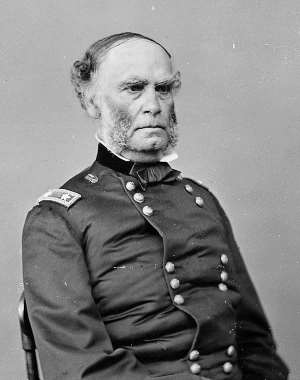
Maj. Gen. Alfred Pleasonton
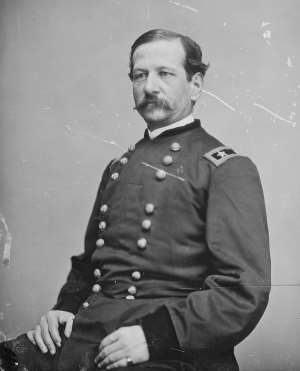
Maj. Gen. William S. Rosecrans
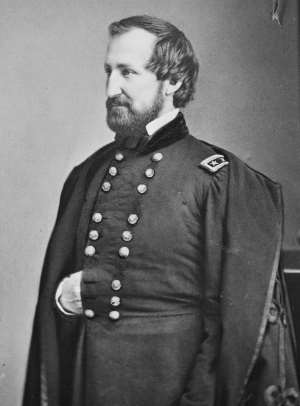
Governor Thomas Carney
